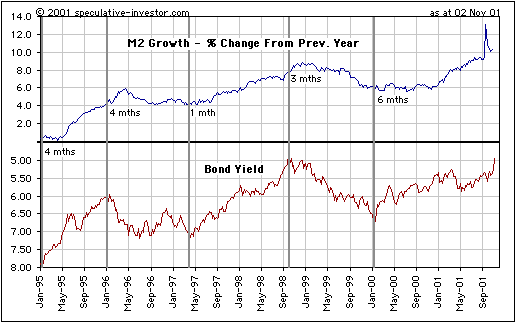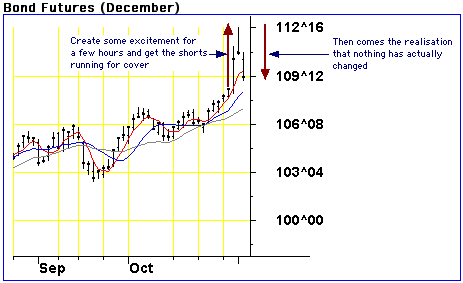
Full Steam
Ahead for the USS "Inflation"
Our forecast for the next 12-18 months
is that the high rate of inflation (money supply growth) over the past
12 months will boost prices and that commodities will be the major beneficiaries
of the inflation. As is usually the case when commodity prices are pushed
higher by inflation, bonds will not fare well.
The above may seem like strange things
to say with the CRB Index close to its lowest level of the past 20 years
and the T-Bond price approaching its 1998 peak. However, last week's Treasury-engineered
bond market rally actually solidifies our belief that large gains in commodity
prices will be seen during 2002-2003. The reason for this is the tight
relationship that exists between bonds and the money supply (M2) growth
rate as depicted on the following chart. The chart compares the year-over-year
M2 growth rate with the T-Bond yield (the bond yield scale is inverted
so that a rising line represents a falling bond yield or a rising bond
price).

It is clear from the above chart that
the bond market has led the M2 growth rate with great consistency over
the past 7 years. Every significant trend reversal in the bond market has
been followed by a trend reversal in the money supply growth rate with
the typical lead time being 3-4 months. The reason this relationship has
worked so well for so long is probably because every sizeable reduction
in long-term interest rates has precipitated new waves of home buying and
mortgage re-financing. If it continues to work then money supply growth
will continue at a fast pace into the early part of next year (at a minimum).
That is, the recent surge in bond prices (plunge in long-term interest
rates) goes a long way towards guaranteeing a higher future inflation
rate and, eventually, higher commodity prices.
We are not the only ones who are aware
of the link between the bond market and the money supply growth rate and
last week's US Government manipulation of market interest rates was a blatant,
and initially successful, attempt to bring this link into play. However,
while all government attempts to manipulate the markets have adverse long-term
consequences, this latest effort may backfire more quickly than usual.
The problem for the manipulators is that the official reason given
for eliminating all future sales of 30-year bonds - that long-term financing
is no longer necessary because deficit-spending will soon be a thing of
the past - is so implausible as to be laughable. As such, the knee-jerk
rally was over within hours (see chart below) and the peak reached on the
morning of November 1st will likely remain unchallenged for a very long
time.

We would be quite willing to buy into
the idea of a deflationary future if that was the direction in which the
evidence pointed. After all, our only goal with these commentaries is to
be as accurate as possible. However, the evidence at the present time points
very decisively towards higher inflation. Note that when we talk about
evidence we are not talking about the latest releases of backward-looking
economic data or the news of the day. Our objective is to correctly anticipate
the future, not get bogged down in the past or even the present (we are
less interested in today's headlines than in what the headlines are going
to be in 6-12 months time). An example of what we are talking about
is the ability of the US financial establishment (the Treasury, the Fed,
the major private banks and brokerages, the GSEs) to keep the money supply
expanding at a rapid rate come what may. This ability has been clearly
demonstrated on many occasions over the past few years, most recently
in the wake of the terrorist attacks.
In the US the M2 money supply has increased
by around 10% over the past 12 months, so the US inflation rate is 10%.
End of story. As discussed in last week's commentary, defining the inflation
rate as a change in prices causes insurmountable problems. This is because
money is spent in different ways at different times, depending on investment
cycles and external factors such as foreign exchange rates. At certain
times commodity prices will be the major beneficiaries of inflation, whereas
at other times financial assets will benefit the most.
Right now we have the ridiculous situation
whereby no amount of money supply growth is seen to be a problem because
the CPI is not increasing at a rapid pace and long-term interest rates
are low. However, this year's massive increase in the money supply is going
to have a huge effect on prices next year. The problem is, by the time
the price indices start to reflect this inflation it will be too late to
take any remedial action. That is, of course, assuming that all the excess
money doesn't just go into stocks or real estate or get added to the trade
deficit.
At some time in the future the US almost
certainly will experience a period of severe and sustained deflation, but
as far as the next 1-2 years are concerned the evidence is pointing in
the opposite direction. One sign that deflationary forces are getting the
upper hand will be that the relationship between money supply growth and
long-term interest rates depicted in the above chart stops working. In
particular, prior to the US experiencing true deflation we should see a
period where falling interest rates do not lead to an increase in the money
supply growth rate. When deflation starts to take hold, falling interest
rates will not stimulate increased borrowing/lending. That is clearly not
the case right now.
Regular financial market forecasts
and
analyses are provided at our web site:
http://www.speculative-investor.com/new/index.html
One-month free trial available.

|

